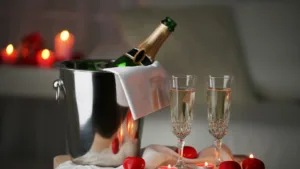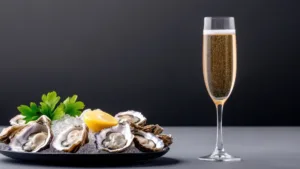Few things capture the essence of jubilation and celebration quite like the pop of a Champagne cork. Champagne has transcended its status as merely a drink; it’s become a symbol of luxury, achievement, and joyful moments. But beyond the glamour and golden bubbles lies a fascinating world of craftsmanship, history, and terroir that sets Champagne apart from any other sparkling wine on earth and this wine guide will help you understand it all!
Champagne isn’t simply “fizzy wine.” It’s a region, a heritage, and a rigorous method of production. Every bottle carries centuries of tradition, meticulous care, and the unique character of the chalky soils of northeastern France. From lavish royal courts to modern weddings, Champagne has always held an esteemed place in the world of wine.
Yet many wine lovers remain mystified by what makes Champagne so special. Why is it pricier than other sparkling wines? What’s the difference between Brut and Extra Brut? How should you serve it? And which bottle should you choose when you’re ready to treat yourself?
If you’ve ever wanted to dive deeper into the world of Champagne, this guide is your perfect starting point. And of course, we’ll share one of our top picks- an award-winning Champagne that belongs on every wine lover’s bucket list.
Also Read: Italian Wine And Food Pairings You Must Try
Table of Contents
ToggleWhat Makes Champagne… Champagne?

First and foremost, “Champagne” is a protected name. To be called Champagne, a wine must:
- Be produced in the Champagne region of France.
- Follow strict regulations regarding grape varieties, vineyard yields, ageing, and production methods.
The primary grapes used are Chardonnay, Pinot Noir, and Meunier. Each grape contributes different qualities: Chardonnay adds finesse and citrus notes, Pinot Noir brings structure and berry flavours, and Pinot Meunier lends fruitiness and softness.
The region’s unique terroir, characterised by chalky soils, imparts freshness and a mineral edge that makes Champagne so distinct.
The Traditional Method (Méthode Traditionnelle)
Champagne’s magic comes from its second fermentation, which happens inside the bottle. Here’s how it works:
- Primary Fermentation: Grapes are fermented into a still base wine.
- Blending (Assemblage): Different wines, often from various years and vineyards, are blended to achieve the house’s signature style.
- Second Fermentation: A mixture of sugar and yeast (liqueur de tirage) is added before bottling, creating carbon dioxide and those iconic bubbles.
- Ageing on Lees: Champagne is aged on its lees (dead yeast cells) for at least 12 months (non-vintage) or three years (vintage), adding complexity, texture, and toasty flavours.
- Riddling and Disgorging: Bottles are gradually turned to collect sediment near the neck, which is then frozen and removed.
- Dosage: A touch of sugar syrup (liqueur d’expédition) is added to adjust sweetness levels.
It’s a labour-intensive process that explains why true Champagne commands a higher price.
Sweetness Levels in Champagne
Champagnes come in various sweetness levels. Here’s a quick guide:
- Brut Nature / Zero Dosage: Bone dry, no added sugar.
- Extra Brut: Very dry, up to 6 g/L of sugar.
- Brut: Dry, the most popular style, up to 12 g/L of sugar.
- Extra Dry: Slightly sweeter than Brut.
- Sec, Demi-Sec, Doux: Progressively sweeter styles, ideal for dessert pairings.
For most occasions, Brut offers the perfect balance of dryness and freshness.
Serving Champagne

A few tips for enjoying Champagne to the fullest:
- Temperature: Serve between 6–8°C. Too cold and you’ll mute aromas; too warm and it loses its crispness.
- Glassware: While flutes are traditional, consider tulip-shaped glasses that allow bubbles to rise while concentrating aromas.
- Storage: Store bottles horizontally in a cool, dark place to maintain cork moisture and freshness.
Food Pairings with Champagne

Champagne’s bright acidity and fine bubbles make it incredibly versatile at the table. Try pairing it with:
- Fresh oysters or seafood platters.
- Sushi and sashimi.
- Soft cheeses like Brie or Camembert.
- Fried foods (try Champagne with pakoras- it’s a match made in heaven!).
- Light poultry or creamy pasta dishes.
Its palate-cleansing nature makes it an excellent choice for meals from start to finish.
Our Recommendation – Laurent Perrier La Cuvée Brut Champagne

If you’re looking for a classic, elegant bottle to mark World Champagne Day, or any special moment, look no further than Laurent Perrier La Cuvée Brut Champagne.
This Champagne exemplifies finesse and purity. It’s predominantly Chardonnay-based, which lends it crisp citrus notes, white blossom aromas, and a fresh, lively finish. Subtle hints of stone fruit and brioche add depth without overwhelming the palate.
Laurent Perrier La Cuvée Brut is ideal for aperitifs or pairing with delicate seafood dishes. It’s a Champagne that feels equally at home at glamorous parties or intimate celebrations.
Importer: Monika Alcobev
Price: ₹9,499
Looking for more such interesting blogs? Click here and check out the India Wines And Spirits Award website.


